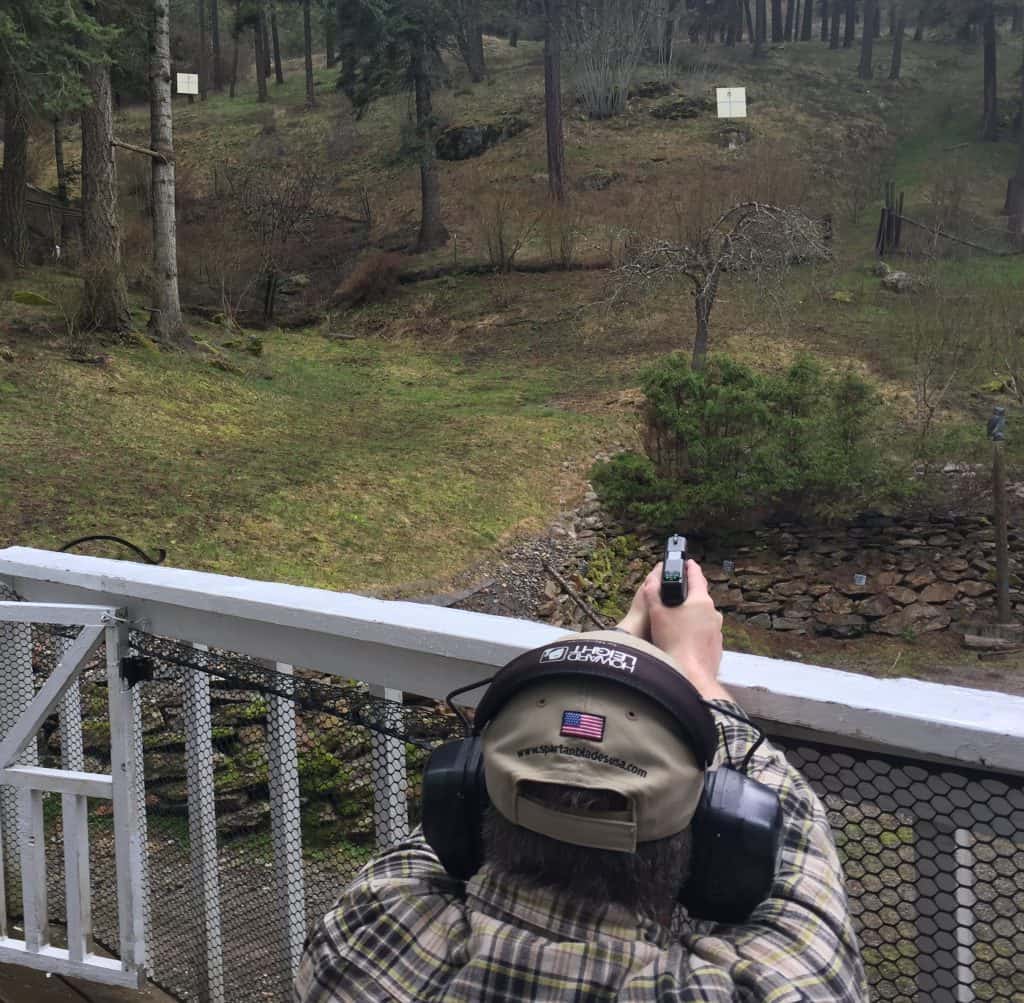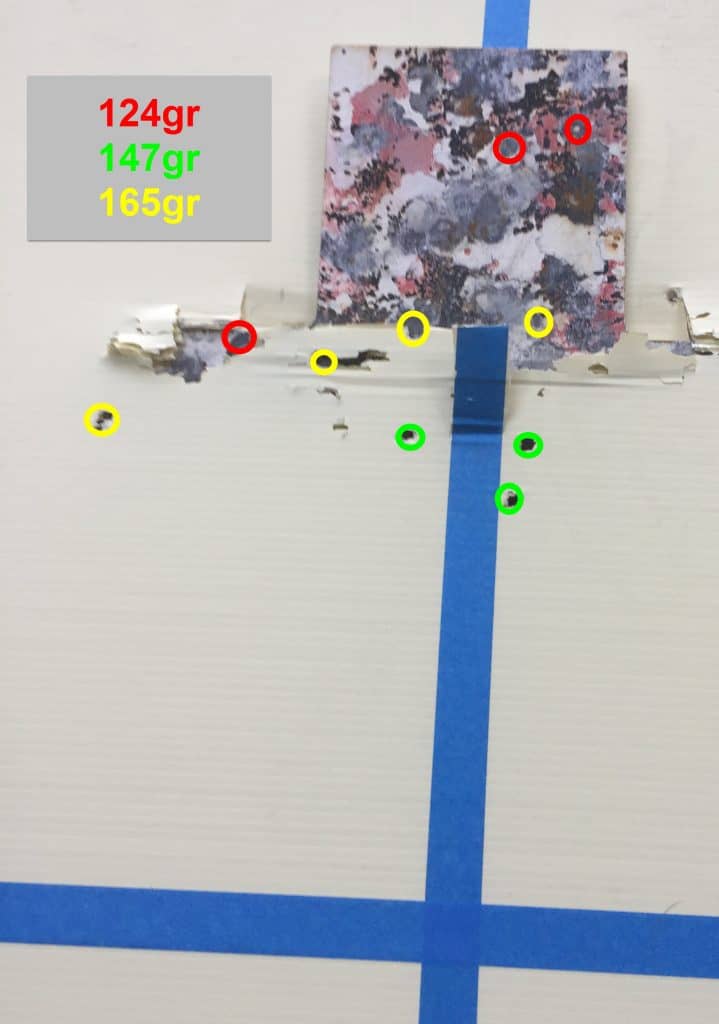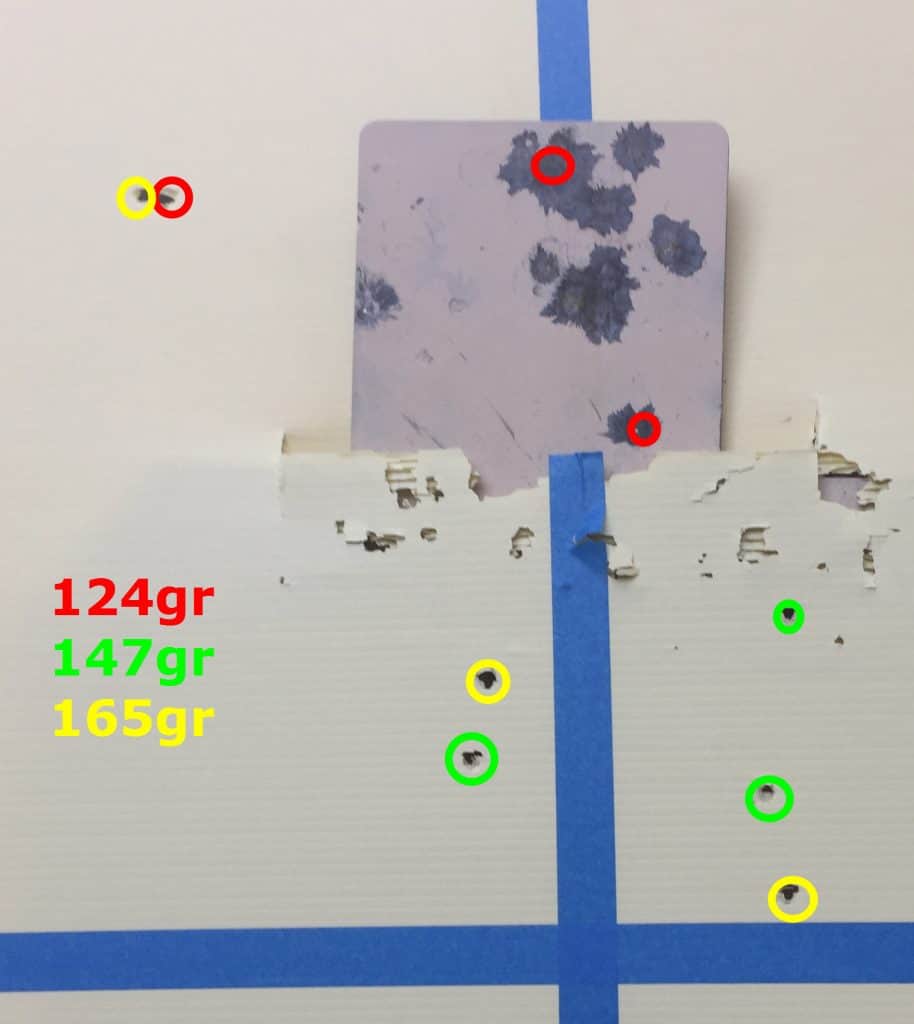8” groups at 85 yards…with a subcompact?
Awhile back, I decided to upgrade the little 3.42″ barrel in my Glock 26.
I changed the ammo I was carrying from 124gr to 147gr and the stock barrel didn’t seem to like it as much.
Specifically, I have steel in my back yard at 65 and 85 yards and my hit percentages dropped considerably with some 147 grain ammo.
So, I ordered a KKM match grade replacement barrel.
But what does “match grade” mean on a defensive pistol with a 3.5” barrel? Does it mean anything on a gun that small?
I decided to find out.
I got a couple of 4’x4’ sheets of corrugated plastic, ran 1” blue painter’s tape horizontally and vertically to make a target that I could see at 85 yards, cut a slit in the plastic so I could hang them over the heads of my steel targets, and started shooting.
Here’s what the setup looked like…I’m aiming at the 65 yard 4 foot x 4 foot target and the 85 yard target is to the left of it:

What I did was shoot 3 rounds of 124gr at the 65 yard target, then 3 at the 85 yard target.
Then, I got on my spotting scope and recorded the hits.
Then I did the same with 147gr and 165gr, except I shot 4x165gr at the 65 yard target.
The specific ammo doesn’t really matter, because the performance is specific to my barrel, but I used Freedom Munitions 124gr SuperMatch, 147gr Hush, and 165gr Hush. Use my DOPE (data on past engagements or data on personal equipment) as a guide, but you need to know your own gear.
The test was barely what I’d consider semi-controlled. I sat on a step-stool and rested my hands on the railing of our deck. I limited some of the variables, but not all. The upside of that is that it means the group sizes I’m sharing are conservative and not extreme examples.
I’ve got a couple of other modifications on this pistol…a Glock extended slide release, a Zev Fulcrum trigger, and a tungsten guide rod. (I didn’t notice any appreciable gain from using the tungsten guide rod and switched back to stock)
I don’t own and did not use a ransom rest or sand bags, which would have improved performance, but the results were eye opening, even without a rest or sand bags.
Here are the results from 65 yards with a Glock 26 subcompact and a KKM match replacement barrel. 124gr hits are red, 147 are green, and 165 are yellow. The tape is 1″ painter’s tape and the head is 6″x6″ for scale.

I’ve been shooting steel with sub-compacts at 100-200 yards for a few years, and I’ve taken a few coyote at 85+ yards, but I’ve never shot paper, so I didn’t know what to expect.
For comparison, a 6″ group at 50 yards and a 12″ group at 100 yards from a rest is pretty good with a defensive pistol.
Frankly, I was shocked at the results.
7/10 hits were within 2” of the midline. It’s pretty clear that the 2 “flyers” were user error. Keep in mind that a 1/64” shift of your front sight on a subcompact will move your impact 6” at 65 yards. That’s less than half a millimeter.
The 85 yard target was just as surprising…the 147 grain was able to hold well under an 8″ group, and I’ll claim responsibility for the flyers which are 7″ left of the centerline. That 7″ at 85 yards represents a 1/82″ shift of the front sight.

So, what’s this tell us?
- Since I didn’t use a ransom rest or sand bags, I can guarantee you that the gun/barrel is capable of even more accuracy than what you see in these pictures.
- Until you know exactly what your gun is capable of, it’s easy to blame your hardware for software (you) related problems. This is a natural tendency, but it will limit your ability to identify problems and improve. Any time I miss a target at these distances, I can skip the gun as the reason and go straight to diagnosing what I did wrong.
- There’s a tendency when shooting at a distance to have a friend call where your shots are hitting so that you can adjust your aim. That ONLY works when the misses are happening because of hardware issues. If the misses are software related and you try a hardware fix, like changing where you aim or your hold, you’re going to spend a lot of time chasing your misses.
- If the subcompact version of a gun that many call a “plastic piece of junk” can shoot like this at 85 yards, it’s fair to assume that ANY gun can shoot tighter groups than this at 21 feet. And, if it’s not, making changes to your fundamentals will tighten your groups faster than making changes to your gun.
- It’s good to know YOUR DOPE for your gear. The drop at 50 yards for my pistol SHOULD be a couple of inches. Instead, it’s 5-7 inches high. Barrels, sight heights, and how your particular eyes interpret your sights are going to make your specific performance different than average performance. In this case, the tighter lock-up of the KKM barrel causes THIS particular barrel to shoot a little high. This can be adjusted with a different height front sight. I ended up going back to a factory barrel so that my DOPE would be the same regardless of which factory hardware I swapped between guns.That being said, here’s a drop chart for pistols that will get you in the ballpark out to 200 yards. With pistol ammo at these distances, the biggest factor is muzzle velocity and not bullet weight or BC, so that’s what I use on the chart.
 (Update: The drop charts now come with every order of 21 Day Alpha Shooter and Dry Fire Training Cards. Get yours now by clicking >HERE<)
(Update: The drop charts now come with every order of 21 Day Alpha Shooter and Dry Fire Training Cards. Get yours now by clicking >HERE<) - I know, with my Glock 26 and this KKM barrel that if I line up my sights with the belly (from 50 to 85 yards) or the base of the neck (at 100 yards), I’m going to get hand sized, center mass groups, as long as I do my part. This is DOPE that ALL law enforcement should learn about their sidearm and that’s not bad for anyone who carries to know…but more importantly…
- If you practice dry firing precisely at the center of a 1” target in your house and take that exact same skill outside, you’ll be able to aim at the center of a man sized target anywhere from 10 feet to 100 yards and expect to make good hits. The exact same trigger manipulation fundamentals work in both situations.
What’s it look like with sub-second splits?
Why’s the video say 55 yards? Because I evidently mis-judged the distance when I originally shot the video and wrote the article. 2x Leupold rangefinders read it as 65 yards, so I changed the article to match.
65, 85, and 100 yard gunfights with a pistol are the definition of extreme and unlikely. But knowing your gun develops earned confidence which, in and of itself, increases high stress performance.
But more importantly, distance shooting with a pistol tests your ability to execute the fundamentals precisely.
Can you keep a hard, clear focus on the front sight, or will you fall for the siren song of glancing at the target?
Can you press the trigger smoothly and straight back to the rear while maintaining perfect sight alignment, or will lateral movement in your trigger press, torque in your grip, or wrist movement cause the bullet to miss the mark?
When you train to be able to execute the fundamentals precisely and automatically, without having to think about them, you’ll be able to perform at a much higher level in a self-defense situation where speed and stress are too high to think through the process.
For the ordinary defensive shooter, long range shooting is a good and fun way to sharpen your skills.
For the 60% of my audience who are military and law enforcement…you go to war with the gun you’ve got. If you’re in a big box store minding your own business when a threat presents itself, you need to know your limits. Can you take care of the threat with the pistol you have on you, or do you need to exit the building, get to your rig, get your long gun, and make re-entry?
Our at-home training curriculum will help you make shots like this…in a fraction of the time and a fraction of the cost of traditional training. It’s specifically designed for shooters who neither have the time nor money to do the volume of live fire training needed to develop this kind of skill. For most shooters, it will help you shoot 2x faster and 2x more accurately in 21 days for less than the cost of a single trip to the range (fees, ammo, fuel). In fact, most people see a dramatic improvement in the first 3-5 days. In fact, you can try it out right now for 5 days for only $1 by clicking >HERE< or get all of the details on the course by clicking >HERE<
12 Comments
MacII
April 24, 2019Ox,
I really like your stuff. I read quite a few different blogs and consider yours the best in my opinion — at least for me. I like the dry fire cards and the other of your training aids that I have purchased. All good stuff and high quality.
In my view, you are the Aston Martin of the shooting world, largely in a race with a bunch of Fords. All adequate but you outclass them as to the value of your information.
Ox
April 26, 2019Wow…thank you so much. I really appreciate that and am not sure what to say except for the fact that I’ve been blessed to get to work with a lot of great shooters and instructors and have had somewhat unique challenges that I’ve had to work through that have allowed me to see things from a different perspective than most.
Train hard and let me know if there’s anything I can do for you.
scott w
September 12, 2017Would like to have the drop charts as well. Really like my dry fire cards. now if I could just get my wife motivated to use them also. 😉
left coast chuck
September 7, 2017I would like to add to John King’s comment. Yes, the Marines did use a better rifle than the Japanese. The Marines used the M-1 Grand which was a 8-round semi-automatic rifle with excellent battle sights. General Patton called it the finest battle weapon ever invented. I trained on the M-1 and carried one through four years active duty and qualified with it yearly for four years in the active reserve and it deserves that reputation in my opinion.
The Japanese used the 5-shot bolt action Arisaka. That was not a bad battle weapon. It had an undeserved reputation for poor quality. Yes, the rifles that were produced after 1944 were rough in finish and ugly, but the basic design was excellent. The Marines just overwhelmed the Japanese with superior firepower. It was more complicated than just that, but it certainly helped.
Several decades ago an amateur gunsmith rechambered a 6.5 Arisaka to .30-06. The first time he fired it, he noticed that it kicked exceedingly harder than when it fired as a 6.5 mm. He took it to a real gunsmith who determined that the chamber was .30-06 sure enough, but the barrel was still 6.5mm, somewhat smaller than 7.62mm. The amateur had neglected to rebarrel the gun. The gun had swaged down the bullet to 6.5 mm and not blown up the action. The rifle was sent to the NRA who tested the function as they too could not believe that the action stood up to the pressures that must have been involved. The rifle again stood up to the test (after taking precautions for the testers to be protected from the expected shrapnel blast). The whole thing was written up in American Rifleman magazine, the official magazine of the NRA and I personally read the article, so I have every reason to believe its veracity. However, both the NRA and I do not recommend fire-forming 30 caliber bullets in a 6.5mm barrel. If you need 6.5 mm bullets, go buy factory formed in that caliber.
MacII
April 24, 2019Left Coast Chuck,
Years ago there was a famous gunsmith named Parker O. Ackley (SP?? — memory ain’t what it used to be). After WW II, he tested to destruction all the major military actions that saw action. He wrote a book about it and I do not recall the title. However, I do recall that the Arisaka with the chrysanthemum crest on the receiver was the only military action he could not destroy with excessive loads. However, it seems to me that it was the 7.7 and not the 6.5 that he was testing.
Rarely, you can see reference to Parker Ackley’s book. It would more accurately set out his testing methods and results. But my memory is that it was the only military action that he could not destroy with overpressure loads.
Just saying it supports you post.
John Coats
September 7, 2017I was just asking around for something like this a few months ago. I would definitely be interested!
Thanks, Coats
left coast chuck
September 7, 2017Every weekend somewhere in the country long range silhouette shooters regularly shoot at 25 meters, 50 meters, 75 meters and 200 meters. The targets are steel chickens, pigs, turkeys and rams. The rams weight 75 pounds. In order to score a point, you must knock the target down, not just hit it. There is nothing more frustrating than to hit a turkey and watch it turn a full 90 degrees. Long range silhouette shooters assume weird positions on the ground because the rule preclude any portion of the gun or gun arm touching the ground. However, if they were able to lie prone and rest their elbows on the ground or rest their elbows on the ground and the barrel of their pistol on a pack or some other steady object, I am quite certain most experience LRPSs would knock down all the targets.
Obviously some shooters use single shot pistols with 14′ barrels, but there is a category for revolvers standing offhand and shooting. Granted again, they use 6″ or 7.5 inch barrels, and usually a .44 magnum in order to generate the foot-pounds of energy necessary to knock over a 75 pound ram at 200 meters.
Long range pistol shooting is not some weird aberration. It is done on a regular basis. It does take practice. It takes quality barrels and quality ammo. And most importantly, as pointed out in the article, it takes quality software. For most of us our guns shoot way better than we do. To poorly paraphrase Shakespeare, “The fault, dear Brutus, is not in our guns but in ourselves.”
Ox
September 7, 2017Absolutely awesome, Chuck. Haven’t heard from you in awhile and I was getting ready to reach out and make sure you were OK. Thanks 🙂
MacII
April 24, 2019Left Coast Chuck,
Again, years ago, Elmer Keith was testing his various pistols. If memory serves, he shot and killed an elk at something like 600 yards. Meaning, of course, that he both hit the elk and hit is accurately enough to kill it at that range with a pistol. I do not recall if it was a 6 or 8-inch barrel but it was hardly the barrel length mentioned in the article.
It, too, was covered in a book that he wrote and which I read over 50 years ago or so.
I had some experience with Rocky Mountain elk years back and always thought that they were about the toughest animal to kill I had hunted, other than brown bear. So, killing one with a pistol at 600 yards was a terrific feat. Not on my best day, ever.
Dave Stark
September 7, 2017Very interested in your bullet drop chart for pistol.
Ox
September 7, 2017Hey Dave, you can get them with the http://TacticalVisionTraining.com course .
Mike
April 7, 2017When available, I would love to get one of your bullet drop charts from you. Please let me know.
Mike
Leave A Response To MacII Cancel reply